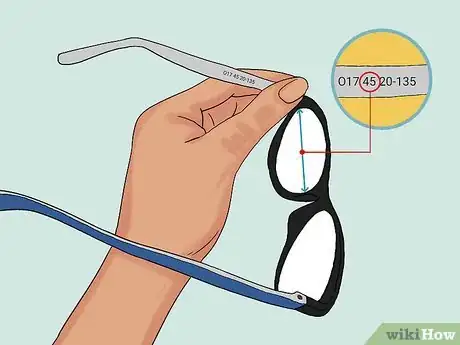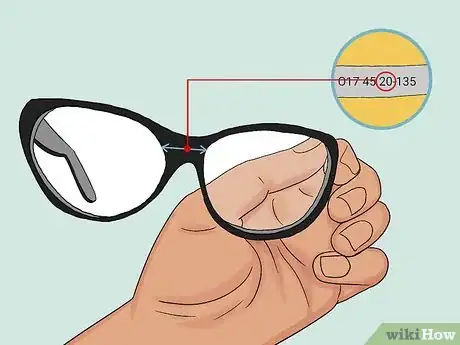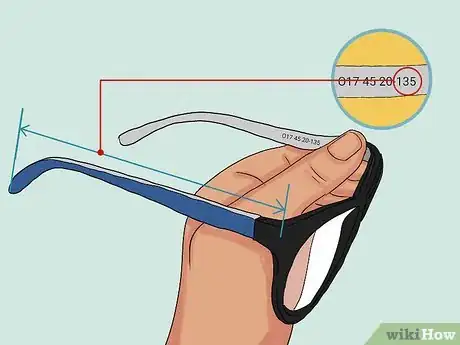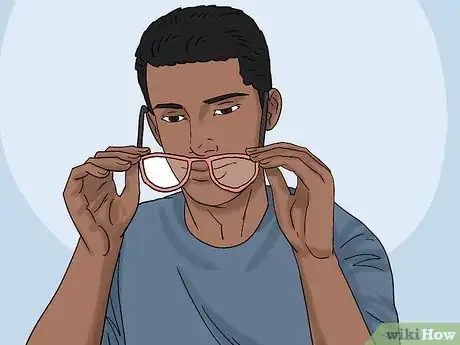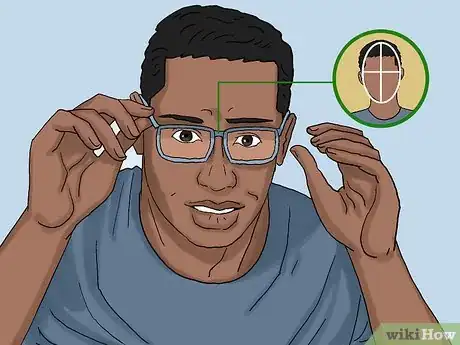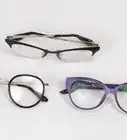This article was co-authored by Alexander Knezevic, MD. Dr. Alexander Knezevic is an Ophthalmologist at the Macy Eye Center in Los Angeles, California. He also is Medical Staff at Cedars-Sinai Medical Center and is a Clinical Instructor of Ophthalmology at UCLA. He graduated with his Doctor of Medicine degree from the University of Nebraska Medical Center, and he completed his Residency at the McGaw Medical Center of Northwestern University. Dr. Knezevic did his Fellowship at the University of California-Irvine, and he’s board certified by the American Board of Ophthalmology. Additionally, Healthgrades has awarded him their Honor Roll award.
This article has been viewed 101,950 times.
Knowing how to read your eyeglasses size will help you find the best fit, especially when shopping for glasses online. Your glasses size is made up of 3 numbers that indicate measurements in millimeters, such as “45 20-135.” The first number will be the eye size, which measures the width of 1 lens. The second number indicates the bridge width, or the distance between the lenses. The third number, or the temple length, tells you how long the arms of the glasses are. To find the perfect fit, you can take your own measurements or have them taken by an optician. Use your measurements to find a comfortable and flattering pair of eyeglasses with the perfect fit!
Steps
Understanding the Measurements
-
1Look for a series of numbers on the inside of your glasses. The measurements should be printed in a small font on the inside of the temple, the bridge, or the earpiece.[1] Your glasses’ manufacturer may also group in extra information with the measurements, such as words and or symbols, but you only need the 3 main numbers to determine your size.
- Different manufacturers write out measurements slightly differently, which can make reading the measurements seem daunting, but just remember to look for the series of 3 numbers. For example, the same measurement could be written “Brand Model 45/20 135,” “45-20-135,” or “45 20-135.”
- Any words or numbers grouped together with capital letters, such as “ESJ-213” or “O17,” represent the frame style or color. Don’t worry about these, since they aren’t relevant to the size measurements.
-
2Find the first 2-digit number to read your eye size. This number measures the width of 1 lens, spanning the distance at its widest point. Your eyes size is the only measurement that falls between 40 to 60 millimetres (1.6 to 2.4 in), so you can use this range to ensure that you’re reading the correct number.[2]
- For example, if your measurements are "45 20-135," your eye size would be 45 millimetres (1.8 in).
- For bifocals and progressive lenses, manufacturers will often break down the lens width and height into separate measurements.
Advertisement -
3Locate the second 2-digit number, or the bridge size. Your bridge size measures the part of your glasses that goes across your nose and connects the two lenses. In the series of 3 numbers, your bridge size will be the only number that falls between 14 to 24 millimetres (0.55 to 0.94 in). It may be printed directly after the eye size, or it might be separated by a small box symbol or a slash.[3]
- For example, if your measurements read "45 20-135," your bridge size would be 20 millimetres (0.79 in).
-
4Find the third number, which measures your glasses’ arm length. The arm length measures the pieces that extend back to rest over the ears. This measurement will be the only 3-digit number falling somewhere between 120 to 150 millimetres (4.7 to 5.9 in), and sometimes it may be separated from the other two measurements by a dash, extra space, model number, or color number.[4]
- For example, if your measurements are "45 20-135," your temple length would be 135 millimetres (5.3 in).
- Some of the most common arm measurements include 135 millimetres (5.3 in), 140 millimetres (5.5 in), 145 millimetres (5.7 in), and 150 millimetres (5.9 in).
Choosing the Right Size
-
1Take your own measurements if you can’t find them on your glasses. If your measurements are missing or rubbed off from wear, you can still use a ruler with millimeter measurements or a cloth measuring tape to find them yourself. Take off your glasses and measure carefully, making sure to write each measurement down as you go.[5]
- Measure horizontally across one lens at its widest point to find your lens width.
- Place the ruler over the top of the glasses and measure from the inner edge of one lens to the other to find your bridge size.
- To find your arm length, measure from one of the arm hinges to the point where the arm begins to curve to fit over the ear.
- If you have trouble finding your measurements, you can also have an optician take them for you.
-
2Use your current pair of glasses as a size reference. If you like the way your current glasses fit, then go ahead and stick with that size. If you notice that your glasses slide around, press into your temples, or pinch you, try some pairs with slightly different measurements.[6]
- For example, if your glasses keep slipping down your nose, your bridge width may be too wide. Look for a pair with a shorter bridge measurement.
- If your glasses pinch your nose or the sides of your head, they are likely too small. Choose a new pair with higher measurements for a better fit.
-
3Try on a variety of glasses to see what works with your face. Every face shape is unique, so these measurements may not perfectly indicate how well the frames will fit or suit your face shape. Experiment with a variety of shapes and sizes at a glasses store or through a try-on service to see what works best.
- This is especially important when purchasing high-fashion frames. Their measurements often differ from standard eyeglasses styles, so it’s important to try them on before you make your purchase.
-
4Make sure your eyes are centered on the width of the lenses. When in doubt, follow this classic rule.[7] If the frames are too wide, they’ll make your eyes look too close together. Frames that are too small will make your eyes look farther apart.
- Choose glasses that are slightly wider than your face for the most flattering effect.
- If there’s more than a finger’s width of space between the temple of the glasses and the side of your face, the glasses are probably too wide. Instead, look for a pair with a smaller eye size.
References
- ↑ https://healthfully.com/do-read-numbers-glasses-frame-6901480.html
- ↑ https://healthfully.com/do-read-numbers-glasses-frame-6901480.html
- ↑ https://www.infographicsarchive.com/eyeglasses-size-chart-choosing-right-frame-size/
- ↑ https://www.infographicsarchive.com/eyeglasses-size-chart-choosing-right-frame-size/
- ↑ https://www.infographicsarchive.com/eyeglasses-size-chart-choosing-right-frame-size/
- ↑ https://youtu.be/9bsZMfaObnA?t=82
- ↑ http://www.businessinsider.com/how-to-buy-glasses-that-fit-your-face-2016-11

